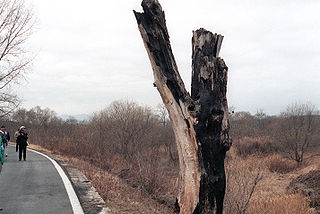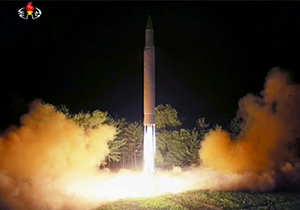 W
WThe history of North Korea began at the end of World War II in 1945. The surrender of Japan led to the division of Korea at the 38th parallel, with the Soviet Union occupying the north, and the United States occupying the south. The Soviet Union and the United States failed to agree on a way to unify the country, and in 1948 they established two separate governments – the Soviet-aligned Democratic People's Republic of Korea and the Western-aligned Republic of Korea – each claiming to be the legitimate government of all of Korea.
 W
WThe Korean axe murder incident was the killing of two United States Army officers, CPT Arthur Bonifas and 1LT Mark Barrett, by North Korean soldiers on August 18, 1976, in the Joint Security Area (JSA) located in the Korean Demilitarized Zone (DMZ). The U.S. Army officers had been part of a work party cutting down a poplar tree in the JSA.
 W
WUnited States Forces Korea (USFK) is a sub-unified command of United States Indo-Pacific Command (USINDOPACOM). USFK is the joint headquarters through which U.S. combat forces would be sent to the fighting components under the South Korea/US (ROK/U.S.) Combined Forces Command (CFC) – the combined ground, air, naval, marine and special operations forces component commands. Major USFK elements include Eighth U.S. Army (EUSA), U.S. Air Forces Korea, U.S. Naval Forces in Korea (CNFK), U.S. Marine Forces Korea (MARFORK) and Special Operations Command Korea (SOCKOR). It was established on July 1, 1957.
 W
WThe Dai Hong Dan incident took place on 29 October 2007, when the North Korean cargo vessel MV Dai Hong Dan was attacked and temporarily seized by Somali pirates off Somalia. The following day, the crew of the vessel overpowered the pirates with the support of a U.S. naval vessel.
 W
WOn 15 April 1969, a United States Navy Lockheed EC-121M Warning Star of Fleet Air Reconnaissance Squadron One (VQ-1) on a reconnaissance mission was shot down by a North Korean MiG-21 aircraft over the Sea of Japan. The plane crashed 90 nautical miles (167 km) off the North Korean coast and all 31 Americans on board were killed, which constitutes the largest single loss of U.S. aircrew during the Cold War era.
 W
WThe history of the Korean People's Army Naval Force is short compared to most modern navies. It began with the creation of a "Maritime Security Force" on June 5, 1946. The headquarters for the force was based in the North Korean city of Wonsan, and was operational by July 1946. The headquarters were then expanded and moved to the capital, Pyongyang, for more effective management of seabound traffic, and the forces were renamed Marine Patrols in December of the same year. The Marine Patrol Academy was established in Wonsan in June 1947 in order to train and commission a professional corps of naval officers.
 W
WThe Korean conflict is an ongoing conflict based on the division of Korea between North Korea and South Korea, both of which claim to be the sole legitimate government and state of all of Korea. During the Cold War, North Korea was backed by the Soviet Union, China, and its communist allies, while South Korea was backed by the United States and its Western allies. The division of Korea by external powers occurred after World War II had ended, starting in 1945, with the official division in 1948, tensions erupted into the Korean War, which lasted from 1950 to 1953. When the war ended, both countries were devastated, with utter destruction of much of the countries, but the division remained. North and South Korea continued a military standoff, with periodic clashes. The conflict survived the end of the Cold War and continues to this day.
 W
WNorth Korea has a military nuclear weapons program and, as of early 2020, is estimated to have an arsenal of approximately 30-40 nuclear weapons and sufficient production of fissile material for 6-7 nuclear weapons per year. North Korea has also stockpiled a significant quantity of chemical and biological weapons. In 2003, North Korea withdrew from the Treaty on the Non-Proliferation of Nuclear Weapons (NPT). Since 2006, the country has been conducting a series of six nuclear tests at increasing levels of expertise, prompting the imposition of sanctions.
 W
WThe 2017–18 North Korea crisis was a period of heightened tension between North Korea and the United States throughout 2017, which began when North Korea conducted a series of missile and nuclear tests that demonstrated the country's ability to launch ballistic missiles beyond its immediate region and suggested that North Korea's nuclear weapons capability was developing at a faster rate than had been assessed by the U.S. intelligence community.
 W
WThere have been a number of North Korean missile tests. North Korea has also fired a number of short-range missiles into the Sea of Japan, in what have been interpreted as political gestures.
 W
WOn 23 January 1968 North Korean patrol boats supported by two Mikoyan-Gurevich MiG-21 fighters captured the USS Pueblo northeast of the North Korean island of Ung-do. The seizure of the Pueblo led to President Lyndon Johnson ordering a show of force with a massive deployment of U.S. air and navy assets to Korea. The airlift and deployment of 200+ aircraft was code named Operation Combat Fox while the deployment of six aircraft carriers plus support vessels was code named Operation Formation Star. The operations were supported by the partial mobilization of reservists for the first time since the Cuban Missile Crisis. CIA A-12 Oxcart reconnaissance overflights over North Korea were used to monitor a feared retaliatory mobilization of North Korean forces and when these flights revealed no mobilization or large scale deployments by North Korean forces, Operation Combat Fox forces were stood down.
 W
WUSS Pueblo (AGER-2) is a Banner-class environmental research ship, attached to Navy intelligence as a spy ship, which was attacked and captured by North Korean forces on 23 January 1968, in what is known today as the "Pueblo incident" or alternatively, as the "Pueblo crisis".